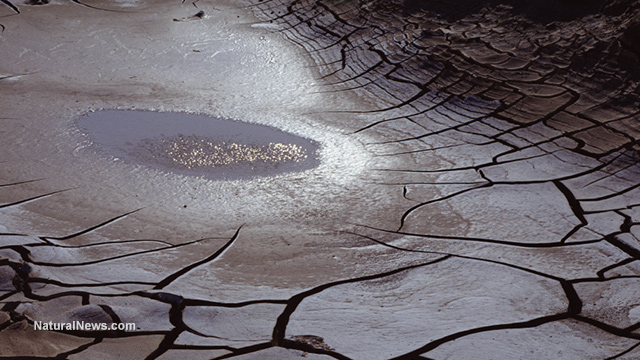Dehydrated: CA residents' drinking water reservoir nearly empty
Monday, November 21, 2016 by: Daniel Barker
Tags: Lake Cachuma, drought, California drinking water

(NaturalNews) In the midst of ongoing and seemingly relentless drought conditions, one of California's important drinking water reservoirs has nearly run dry.
Lake Cachuma, a once-huge reservoir that supplies water to the city of Santa Barbara and surrounding areas, has shrunk dramatically – this summer, water levels dropped to an all-time record low of 7 percent capacity.
And there's little hope of relief. Levels are expected to drop even further by January – to the point where water can no longer be distributed from Lake Cachuma.
'A future without water'
This is bad news for the nearly half a million residents of Santa Barbara County who depend on the reservoir for drinking water and crop irrigation.From The Washington Post:
"Barring a winter miracle of massive snows and rains extending into April, weather that has forsaken Southern California for more than five years, there will be 'no water available next year from the reservoir,' said Duane Stroup, deputy area manager for the south-central region of the federal Bureau of Reclamation.
"The entire Santa Ynez Valley will then face a future without water. The 3,000-acre reservoir supplies half of what the valley needs to recharge an underground aquifer that nearly every household, business and farm uses to pump water."
If the coming winter is as dry as the last, the wells will go dry and farmers will be unable to bring crops to harvest, said Bruce Wales, general manager of the local water conservation district.
Wales is concerned that the Santa Barbara area could soon face conditions similar to those in California's Central Valley, where 2,000 wells recently dried up, requiring the state to set up huge water tanks to supply residents with enough water to wash and flush toilets.
Scrambling for solutions
Smaller communities in the area are looking for alternative solutions to meet their water needs:"The cities of Solvang and Buellton are making plans to tap alternative water sources. The community of Montecito is scrambling to buy whatever the state and private vendors can provide."
Meanwhile, Santa Barbara is deliberating a complete ban on outdoor water use, while residents anxiously await the completion of a desalination plant capable of turning 3 million gallons of seawater per day into drinking water.
As drought conditions worsen, the Santa Barbara area is expected to begin experiencing a negative economic effect. The county has long been favored by the rich and famous as a place to enjoy the good life, but the appeal is beginning to fade, as use restrictions mean less water for lush lawns, landscaping and swimming pools.
Santa Barbara County has long been a major drain on the state's water resources. Lake Cachuma was created in response to a major drought in the middle of the 20th century, and the reservoir was filled with water trapped by Bradbury Dam.
The reservoir, which took five years to fill, distributed water to Santa Barbara County via an "elaborate tunnel and conduit" system that delivered water to intake plants in the area and to an aquifer located in the valley.
Due to its use as a source of drinking water, swimming has always been off-limits in Lake Cachuma, but the lake was stocked with a variety of game fish and was popular among anglers, until the drought dropped water levels far below those of years past.
Even a mandatory 35 percent cut in water use ordered one year ago has not been enough to stop the steady decrease in the water level.
Desalination is only a partial solution
The desalination plant was built 20 years ago during another drought, but was never put into use, due to a relaxing of drought conditions. When it does finally go online, it will only provide about 30 percent of Santa Barbara's water needs, and critics argue that desalination comes with a steep environmental cost.If drought conditions in California continue, many areas of the state face a very uncertain and worrisome future.
Sources:
WashingtonPost.com
Independent.com
EcoWatch.com
Lake Cachuma at FETCH.news
Get independent news alerts on natural cures, food lab tests, cannabis medicine, science, robotics, drones, privacy and more.
Take Action: Support Natural News by linking to this article from your website
Permalink to this article:
Embed article link: (copy HTML code below):
Reprinting this article:
Non-commercial use OK, cite NaturalNews.com with clickable link.
Follow Natural News on Facebook, Twitter, Google Plus, and Pinterest
- Newly released JFK files reveal Pentagon's role in creating Lyme disease and covid in the same lab
- The hidden dangers in your kitchen: How cooking methods impact diabetes, cancer and aging
- DEADLY DECEPTION: How COVID vaccines increased mortality rates and why authorities hid the truth
- CDC finally halts $11 billion COVID funding scam as health officials admit the ‘pandemic’ was a fraud
- Arkansas embraces medical freedom with landmark ivermectin law
- GAIN-OF-FUNCTION CAT-BIRD-FLU now on the rise as nearly a dozen cats in Colorado "test positive" for Bird Flu due to contaminated cat food
- Lab leak confirmed? Boris Johnson's stunning reversal on COVID origins sparks global debate
- Home gardening for preppers: A beginner's guide to growing your own food
- Trump's greatest betrayal so far: Accelerating Middle East wars, silencing dissent, and serving Zionist masters
- Why you should think twice before buying mainstream toothpaste formulas
- Cartels shift tactics: Kidnappings and organ trafficking surge as border crossings plummet under Trump policies
- Was JFK's assassination orchestrated by a CIA double agent? New evidence points to James Angleton as the “architect”
- ATTENTION PRESIDENT TRUMP: Please WITHDRAW your nomination of Dr. Susan Monarez for CDC Director as she is a VAX FANATIC and TOXIC JAB ZEALOT
- Key nodes of Federal Government censorship
- Here are TEN all-natural ways to protect your garden without using harmful chemicals
- Record honeybee deaths devastate U.S. agriculture, pesticides under scrutiny
- Speaker Johnson warns Congress may defund or disband rogue courts targeting Trump
- Paper or plastic? The environmental deception behind bag bans
- Newly released JFK files reveal Pentagon's role in creating Lyme disease and covid in the same lab
- Elon Musk: Aliens could be here on Earth RIGHT NOW
- Festive flavors: The sweet history, nutritional profile and health benefits of pecan pie
- Trump reverses course on Gaza plan, says “nobody is expelling Palestinians”
- Reclaim your health: How midlife exercise reverses years of inactivity
- Big Pharma's $8 Billion bribery scheme exposed: how doctors are pushed to prescribe junk science, not heal
- Boys are back in town: Trump’s patriotic alpha crew takes the wheel while toxic females ride in the backseat
- EPA advisor admits the agency is funneling billions to climate groups ahead of Trump’s return to White House
- Space war brewing? Russia threatens to destroy Starlink satellites
- Survival 101: Effective EMF blocking techniques
- A lack of integrity in Academia: Harvard professor found GUILTY of fraudulent research to promote CRT theory
- Mike Adams Sermon 66: God will DESTROY ISRAEL for its wickedness
- 5 Simple steps to boost your brainpower: How to strengthen executive function in a distracted world
- Rep. Nancy Mace introduces bill to ban biological males from female facilities on federal property
- Sugarcane extract superior to cholesterol-lowering drugs?
- WHO focusing more on policing speech about public health and implementing global surveillance systems
- Pilots report mysterious lights 'moving at extreme speeds' across Oregon skies
- Dr. Mike Yeadon releases 15-minute testimony - WATCH - about genocidal intent of COVID “vaccines”
- EPA advisor admits the agency is funneling billions to climate groups ahead of Trump’s return to White House
- The Health Ranger releases “Vaccine Zombie” song and music video, using AI-animated zombies for the music video
- California's social media censorship law struck down: A victory for free speech or a threat to online safety?
- Dr. Mike Yeadon releases 15-minute testimony - WATCH - about genocidal intent of COVID “vaccines”
- The pandemic as a tool for INDOCTRINATION: Understanding “The Indoctrinated Brain” by Dr. Michael Nehls
- Florida takes a stand: DeSantis proposes permanent ban on mRNA vaccine mandates
- Mike Adams releases country western hit single: Goin’ Back in Time is Comin’ Home
- Mike Adams releases music poetry sensation: A Child of God
- “Why we influenced the 2020 elections”: Facebook files reveal the coordinated effort to bury the Hunter Biden laptop story
- RFK Jr. clears key hurdle: Sen. Susan Collins backs controversial HHS nominee, signaling a new era for health policy
- Unpacking the Lies That We’ve Been Fed – new song and music video released by Mike Adams, the Health Ranger
- Mike Adams releases new song and music video: Nothing More Disgusting Than a Globalist
- Newly released JFK files reveal Pentagon's role in creating Lyme disease and covid in the same lab
- Congratulations to the FULLY UNVACCINATED as you resisted the COVID-19 PROPAGANDA MACHINE fueled by over $100 BILLION
- Michigan sheriff announces criminal investigation into 2020 election crimes, Dominion Voting Systems
- Israeli soldiers accused of even more torture and abuse in the West Bank
- Migrants are taking advantage of recent hurricanes to scam residents and loot their homes
- House Intelligence Committee calls for the ARREST and PROSECUTION of Dr. Anthony Fauci
- Red Cross issues warning to stop blood plasma donations from vaccinated people
- Scientists confirm: GENIUS brain function can be spontaneously unleashed in humans without any apparent cause
- EPA advisor admits the agency is funneling billions to climate groups ahead of Trump’s return to White House
- HYSSOP: What research reveals about the health benefits of this ancient holy herb
- Two containers with completed ballots fall out of truck in Florida
- Fully vaccinated about to see “tsunami” of illness and death, warns virologist
- Global leaders unite to clamp down on “misinformation” with UN-backed Cascais Declaration
- BREAKING: 2025 NDAA authorizes mandatory military draft of WOMEN across America… as Pentagon pursues global NUCLEAR war with both Russia and China at the same time
- Michael Yon warns of a ZIONIST TAKEOVER in Trump’s second administration
- BOMBSHELL: DNA testing kits are a SCAM to develop ethnic-specific bioweapons
- Ozempic and Wegovy weight loss drugs are injectable LIZARD VENOM PEPTIDES that may unleash a devastating wave of organ failure… side effects align with symptoms of SNAKE BITES
- Israeli soldiers accused of even more torture and abuse in the West Bank
- These 13 countries just signed an agreement to engineer a global FAMINE by destroying food supply
- NASA admits that climate change occurs because of changes in Earth’s solar orbit, and NOT because of SUVs and fossil fuels
- RFK Jr. clears key hurdle: Sen. Susan Collins backs controversial HHS nominee, signaling a new era for health policy
- Sermon 30: How Jesus reveals Caesar’s FAKE CURRENCY and FALSE AUTHORITY
- Coriander seeds: Ancient medicine backed by modern science
- Arizona officials claim Maricopa County needs 10-13 days to tabulate results of the election
Science News & Studies
Medicine News and Information
Food News & Studies
Health News & Studies
Herbs News & Information
Pollution News & Studies
Cancer News & Studies
Climate News & Studies
Survival News & Information
Gear News & Information
News covering technology, stocks, hackers, and more



"Big Tech and mainstream media are constantly trying to silence the independent voices that dare to bring you the truth about toxic food ingredients, dangerous medications and the failed, fraudulent science of the profit-driven medical establishment.
Email is one of the best ways to make sure you stay informed, without the censorship of the tech giants (Google, Apple, Facebook, Twitter, YouTube, etc.). Stay informed and you'll even likely learn information that may help save your own life."
–The Health Ranger, Mike Adams












































